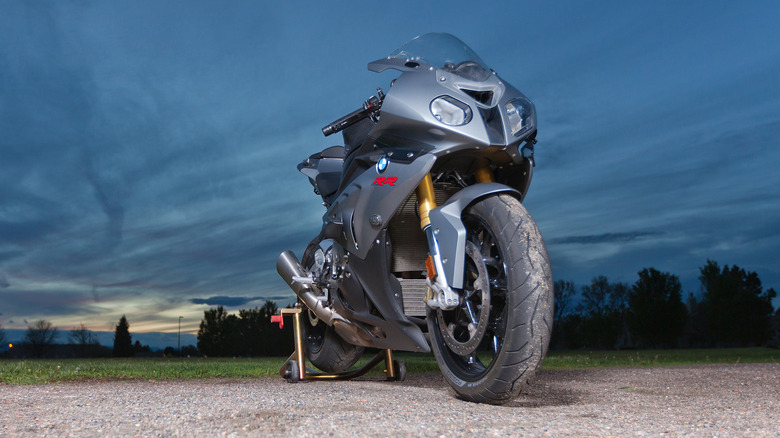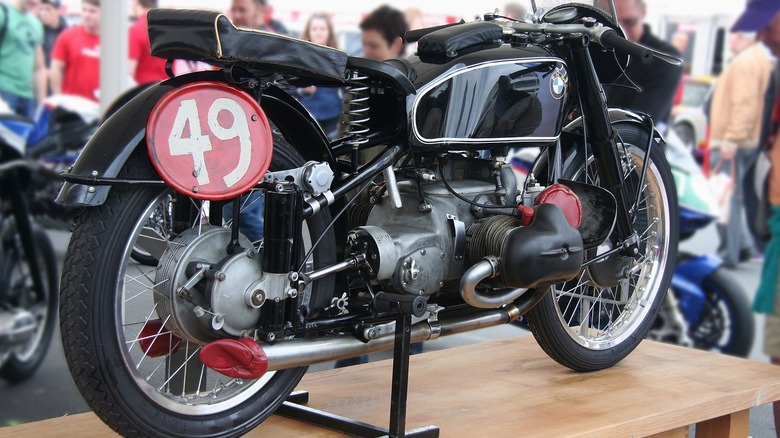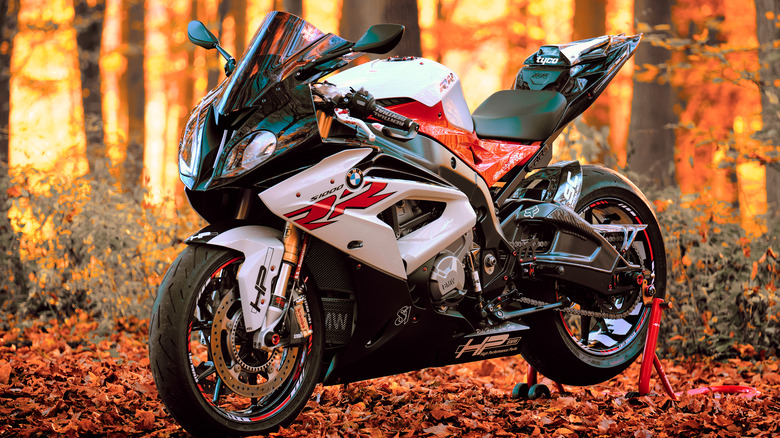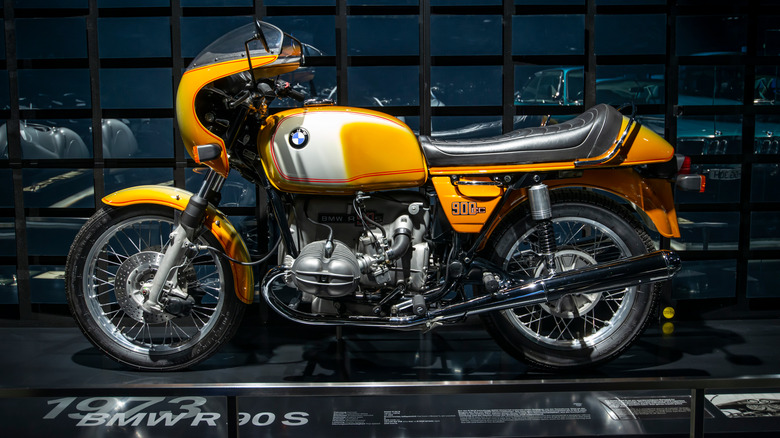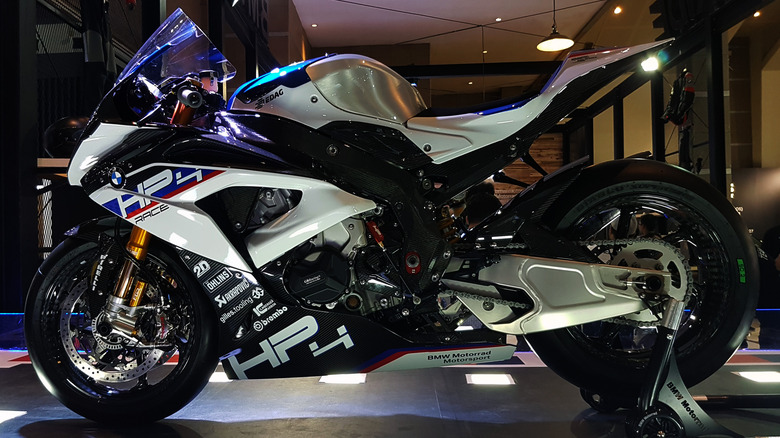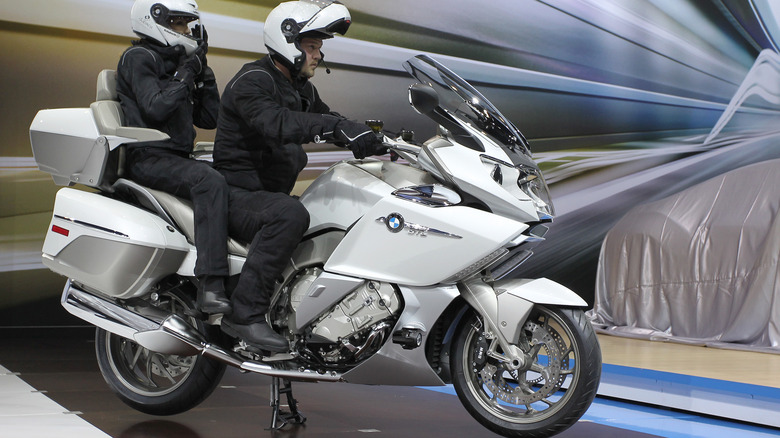5 Of The Fastest BMW Motorcycles Ever Built
BMW is probably known to most people as the manufacturer of luxury cars and SUVs that took control of the Mini brand in 1996, but BMW began making motorcycles in 1923, five years before it produced its first four-wheeled vehicle. That bike, the R 32, was designed by Max Friz and exhibited at that year's Berlin Motor Show.
It featured a twin-cylinder "boxer" engine and a direct driveshaft with a universal joint, both features that are still integral elements of current BMW motorcycles. The R32 had an 8.5 horsepower motor and could only manage a top speed of 95 km/h (about 59 mph), but some of BMW's modern bikes are speed demons that race in the FIM Superbike and Endurance racing World Championships.
That racing pedigree has inspired the design and manufacture of many pavement-scorching BMW two-wheelers over the years. Here are five of the fastest motorcycles BMW has made in its 101 years in the business.
Type 255 Kompressor
Not long after building that first R32, BMW's engineers began working on a bike that could compete in the prestigious Isle of Man racing series. By the mid-1930s, the RS 255 Kompressor was a championship bike, winning races for Georg Meier and Walter Zeller.
The Kompressor's Zoller supercharger gave the 492.6 cubic centimeter flat twin engine a maximum output of 80 horsepower, although it was usually tuned down during races for reliability's sake. BMW riders initially found the Kompressor hard to handle, but the addition of a rear suspension in 1937 cleared up most of those issues, and Meier won the 1939 Isle of Man Senior Tourist Trophy on a Kompressor.
It had a top speed of 140 miles per hour, an impressive figure for the era, and remained in production through 1939 when World War II interrupted many of Germany's industrial efforts.
S1000RR
Motorcycles evolved with time, technology, and rider tastes throughout the 20th century and into the 21st, and by the early 2000s, superbikes like the Kawasaki Ninja and the Suzuki GSX series were the rage. BMW responded to the marketplace's changing sensibilities by introducing the S1000RR in 2009. The S1000RR was in some ways a happy accident; BMW had bowed out of competitive racing in the 1950s and was looking to get back in the game, but decided that MotoGP was too risky an arena to enter and focused on the World Superbike circuit.
The S1000RR was designed as a racing model, but BMW needed to sell 1,000 to consumers for the bike to qualify to run in WSB races. It debuted on consumer markets in 2009 with a 193 horsepower engine, traction control, and anti-lock brakes. The model is still in production and is in its fourth generation, following updates in 2012, 2015, and 2019. The 2024 edition features a 205 horsepower engine capable of slinging the bike to a top speed of 188 mph. To keep all that power under control, the S1000RR also has cutting-edge electronic safety systems, including slide control and brake assist technology.
R90S
In between the production of BMW's earliest asphalt melters and the peak of the modern superbike era, the German automaker developed a bike that was long on both style and performance. By the 1970s, the Honda CB750 and Kawasaki Z1 had established the superbike category, and BMW felt the need to throw its helmet into the ring.
In 1973, Bob Lutz, who ran BMW's Motorrad division at the time, brought in designer Hans Muth, who had previously crafted the Suzuki Katana. Lutz told Adventure Rider that BMW's reputation had fallen quite far from its racing heyday and motorcycle sales had fallen to around 10,000 units a year, mostly to law enforcement.
"Retail was nearly non-existent," Lutz said. "We just didn't have it and were treated as a bit of a joke by the magazines. They'd write, 'BMWs ... nice touring motorcycles for elderly people,' and stuff like that. Not a reputation that boded well for the future."
The R90S quickly reversed those fortunes with its stripped-down bikini fairing and high-torque, high-compression 900 cc engine. The R90S had a top speed of 124 mph and was an instant success on the track, taking first and second place in its first Superbike series race. It stayed in production through 1976, when it was replaced by the R100S.
HP4 Race
For pure speed and power, few motorcycles from any manufacturer match up to BMW's HP4 Race. This sleek bike uses carbon-fiber and titanium construction to keep the weight to a remarkable 146 kilograms (about 322 pounds), and the 215 horsepower four-cylinder 999 cc engine can whip the HP4 Race into a nearly 190 mph frenzy. The HP4 race is designed for the track and not restricted by any racing series homologation requirements, but BMW's engineers still managed to build a machine that is as refined as it is powerful.
Only 750 production copes of the HP4 Race were made, and Revzilla's Spurgeon Dunbar was able to take one of the $78,000 bikes for a spin around New Jersey Motorsports Park. After a few laps adjusting to the HP4's gut-pummeling power, he quickly became enamored with all aspects of the bike. "The HP4 Race sounds like a rabid hellhound released from a cage, but it handles itself with the refinement of the Queen Mother at high tea," he wrote. "As I relaxed, the bike became progressively easier to ride."
K1600GTL
BMW's K1600GTL grand touring bike was introduced in 2011 with a 1,649 cc six-cylinder engine. That's bigger than the motor in some cars, and the K1600GTL is still in production today. The engine in the 2024 version puts out 160 horsepower and 132.7 pound-feet of torque, which can haul the nearly 800-pound bike to a top speed of more than 120 mph. Pillion riders enjoy a comfortable throne with a high seat back and armrest, and newer models can be purchased with modern accessories like BMW's Navigator GPS, keyless riding, and central locking systems.
Greg Drevenstedt of Rider Magazine took a K1600GTL on a long-distance road test and came away suitably impressed by the bike's comfort, luxury features, and performance. "The connection between the right grip and the rear wheel is direct," he wrote, "and the growl from the 6-into-2 exhaust with howitzer-sized cans taps into the brain's pleasure center."
